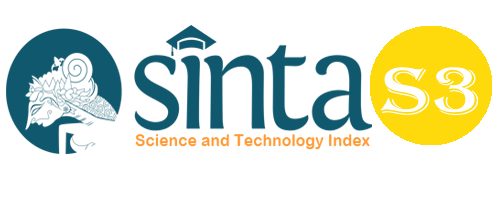Perception of Transformational Leadership and Commitment on Employee Performance
Abstract
Employee performance is the center of attention in all government agencies. Employee performance can be influenced by many variables such as leadership and commitment. This study aims to determine the effect of transformational leadership and commitment on the performance of the employees of the Regional Fisheries Office of Morowali District, Central Sulawesi Province. This study used quantitative methods. The population of this study was all employees of the Regional Fisheries Office of Morowali District with a total of 87 employees. The sample was determined with a census sampling technique so that all populations were sampled. Data were collected from observation, questionnaires, and written documents. Then, the data were analyzed using descriptive statistics and multiple linear regression to test the research hypotheses. The results showed that transformational leadership and commitment greatly affect the employee performance of the Regional Fisheries Office of Morowali District. The results of descriptive statistics showed that the leaders in the Regional Fisheries Office of Morowali District have a clear vision and mission; show an optimistic attitude; and can stimulate subordinates to be creative. Meanwhile, the leaders never openly corrected or criticized their subordinates. It has a low response because of the leader's closed attitude towards subordinates, especially in providing corrections and criticism. In terms of commitment, employees at this office feel that they have a high emotional bond with the organization. However, they easily leave the office as they think that what they are doing is less valuable.
Keywords
Full Text:
PDFReferences
Abbas, M., & Ali, R. (2021). Transformational versus transactional leadership styles and project success: A meta-analytic review. European Management Journal, S0263237321001547. https://doi.org/10.1016/j.emj.2021.10.011
Allen, N., & Meyer, J. (1990). The Measurement and Antecedents of Affective, Continuance and Normative Commitment to the Organization. Journal of Occupational Psychology, 63. https://doi.org/10.1111/j.2044-8325.1990.tb00506.x
Alqudah, IHA, Carballo-Penela, A., & Ruzo-Sanmartín, E. (2022). High-performance human resource management practices and readiness for change: An integrative model including affective commitment, employees' performance, and the moderating role of hierarchy culture. European Research on Management and Business Economics, 28(1), 100177. https://doi.org/10.1016/j.iedeen.2021.100177
Baird, N., Martin, LJ, & Benson, AJ (2020). A dynamic view of coach transformational leadership: How leadership perceptions relate to task cohesion and team potency. Psychology of Sport and Exercise, 51, 101789. https://doi.org/10.1016/j.psychsport.2020.101789
Bass, BM, Avolio, BJ, Jung, DI, & Berson, Y. (2003). Predicting unit performance by assessing transformational and transactional leadership. Journal of Applied Psychology, 88(2), 207. https://doi.org/10.1037/0021-9010.88.2.207
Bass, BM, & Riggio, RE (2006). Transformational leadership (2nd Ed). Mahwah, NJ: L. Erlbaum Associates.
Bennis, W. (2007). The challenges of leadership in the modern world: Introduction to the special issue. American Psychologist, 62(1), 2.
Bhardwaj, A., Mishra, S., & Jain, TK (2021). Analysis of strategic leadership for organizational transformation and employee engagement. Materials Today: Proceedings, 37, 161–165. https://doi.org/10.1016/j.matpr.2020.04.774
Bingham, JB, Mitchell, BW, Bishop, DG, & Allen, NJ (2013). Working for a higher purpose: A theoretical framework for commitment to organization-sponsored causes. Human Resource Management Review, 23(2), 174–189. https://doi.org/10.1016/j.hrmr.2012.07.004
Darolia, CR, Kumari, P., & Darolia, S. (2010). Perceived organizational support, work motivation, and organizational commitment as determinants of job performance. Journal of the Indian Academy of Applied Psychology, 36(1), 69–78.
Day, DV, & Antonakis, J. (2012). The nature of leadership. SAGE Publications, Inc.
Denis, J.-L., Langley, A., & Sergi, V. (2012). Leadership in the Plural. Academy of Management Annals, 6(1), 211–283. https://doi.org/10.5465/19416520.2012.667612
D'Innocenzo, L., Mathieu, JE, & Kukenberger, MR (2016). A meta-analysis of different forms of shared leadership–team performance relations. Journal of Management, 42(7), 1964–1991.
Eliyana, A., Ma'arif, S., & Muzakki. (2019). Job satisfaction and organizational commitment effect in the transformational leadership towards employee performance. European Research on Management and Business Economics, 25(3), 144–150. https://doi.org/10.1016/j.iedeen.2019.05.001
English, B., Morrison, D., & Chalon, C. (2010). Moderator effects of organizational tenure on the relationship between psychological climate and affective commitment. Journal of Management Development.
GAO, R. (Chuang R., Murphy, WH, & Anderson, RE (2020). Transformational leadership effects on salespeople's attitudes, striving, and performance. Journal of Business Research, 110, 237–245. https://doi. org/10.1016/j.jbusres.2020.01.023
Ge, Z., Hu, Q., Goh, C.-H., & Zhao, R. (2021). Action-dependent commitment in vertical collaborations: The effect of demand-creating innovations in a supply chain. Transportation Research Part E: Logistics and Transportation Review, 147, 102164. https://doi.org/10.1016/j.tre.2020.102164
Ghozali, I. (2011). Multivariate Applications with IBM SPSS 19 Program (5th ed.). Semarang: Diponegoro University Publishing Agency.
Gulluce, A. ., Kaygin, E., Kafadar, SB, & Atay, M. (2016). The Relationship between Transformational Leadership and Organizational Commitment: A Study on the Bank Employees. Journal of Service Science and Management, 09(03), 263–275. https://doi.org/10.4236/jssm.2016.93033
Hackman, MZ, & Johnson, CE (2013). Leadership: A communication perspective. Waveland press.
Imamoglu, SZ, Ince, H., Turkcan, H., & Atakay, B. (2019). The Effect of Organizational Justice and Organizational Commitment on Knowledge Sharing and Firm Performance. Procedia Computer Science, 158, 899–906. https://doi.org/10.1016/j.procs.2019.09.129
Jensen, M., Potočnik, K., & Chaudhry, S. (2020). A mixed-methods study of CEO transformational leadership and firm performance. European Management Journal, 38(6), 836–845. https://doi.org/10.1016/j.emj.2020.05.004
Kaiser, RB, McGinnis, JL, & Overfield, DV (2012). The how and what of leadership. Consulting Psychology Journal: Practice and Research, 64(2), 119.
Kammerhoff, J., Lauenstein, O., & Schütz, A. (2019). Leading toward harmony – Different types of conflict mediate how followers' perceptions of transformational leadership are related to job satisfaction and performance. European Management Journal, 37(2), 210–221. https://doi.org/10.1016/j.emj.2018.06.03
Kim, H., Im, J., & Shin, YH (2021). The impact of transformational leadership and commitment to change on restaurant employees' quality of work life during a crisis. Journal of Hospitality and Tourism Management, 48, 322–330. https://doi.org/10.1016/j.jhtm.2021.07.010
Knies, E., Jacobsen, C., & Tummers, L. (2016). Leadership and organizational performance. Routledge Companion to Leadership, 404–418.
Latan, H., Chiappetta Jabbour, CJ, Lopes de Sousa Jabbour, AB, Wamba, SF, & Shahbaz, M. (2018). Effects of environmental strategy, environmental uncertainty and top management's commitment on corporate environmental performance: The role of environmental management accounting. Journal of Cleaner Production, 180, 297–306. https://doi.org/10.1016/j.jclepro.2018.01.106
Lewin, C. (2005). Elementary quantitative methods. Research Methods in the Social Sciences, 215–225.
Li, Y., Liu, Z., Qin, K., Cui, J., Zeng, X., Ji, M. … Li, Y. (2021). Organizational trust and safety operation behavior in airline pilots: The mediating effects of organizational identification and organizational commitment. Journal of Air Transport Management, 92, 102018. https://doi.org/10.1016/j.jairtraman.2021.102018
Manata, B., Garcia, AJ, Mollaoglu, S., & Miller, VD (2020). The effect of commitment differentiation on integrated project delivery team dynamics: The critical roles of goal alignment, communication behaviors, and decision quality. International Journal of Project Management, S0263786320301265. https://doi.org/10.1016/j.ijproman.2020.12.003
Martinsuo, M., Hensman, N., Artto, K., Kujala, J., & Jaafari, A. (2006). Project-based management as an organizational innovation: Drivers, changes, and benefits of adopting project-based management. Project Management Journal, 37(3), 87–97.
McCauley, CD, & Palus, CJ (2020). Developing the theory and practice of leadership development: A relational view. The Leadership Quarterly, 101456. https://doi.org/10.1016/j.leaqua.2020.101456
Meyer, JP, Morin, AJS, Stanley, LJ, & Maltin, ER (2019). Teachers' dual commitment to the organization and occupation: A person-centered investigation. Teaching and Teacher Education, 77, 100–111. https://doi.org/10.1016/j.tate.2018.09.009
Meyer, JP, Morin, AJS, & Vandenberghe, C. (2015). Dual commitment to organization and supervisor: A person-centered approach. Journal of Vocational Behavior, 88, 56–72. https://doi.org/10.1016/j.jvb.2015.02.001
Meyer, JP, Stanley, LJ, & Parfyonova, NM (2012). Employee commitment in context: The nature and implications of commitment profiles. Journal of Vocational Behavior, 80(1), 1–16. https://doi.org/10.1016/j.jvb.2011.07.002
Motowidlo, SJ, & Kell, HJ (2012). Job Performance. In I. Weiner (Ed.), Handbook of Psychology, Second Edition (p. hop212005). Hoboken, NJ, USA: John Wiley & Sons, Inc. https://doi.org/10.1002/9781118133880.hop212005
Moynihan, DP, Pandey, SK, & Wright, BE (2012). Setting the table: How transformational leadership fosters performance information use. Journal of Public Administration Research and Theory, 22(1), 143–164. https://doi.org/doi:10.1093/jopart/mur024
Nanjundeswaraswamy, TS, & Swamy, DR (2014). Leadership styles. Advances in Management, 7(2), 57–62.
Nasomboon, B. (2014). The relationship among leadership commitment, organizational performance, and employee engagement. International Business Research, 7(9), 77.
Nunnally, JC (1975). Psychometric Theory—25 Years Ago and Now. Educational Researcher, 4(10), 7–21. https://doi.org/10.3102/0013189X004010007
Ojo, AO, & Fauzi, MA (2020). Environmental awareness and leadership commitment as determinants of IT professional’s engagement in Green IT practices for environmental performance. Sustainable Production and Consumption, 24, 298–307. https://doi.org/10.1016/j.spc.2020.07.017
Olanipekun, AO, Xia, B., & Nguyen, H.-T. (2017). Motivation and Owner Commitment for Improving the Delivery Performance of Green Building Projects: A Research Framework. Procedia Engineering, 180, 71–81. https://doi.org/10.1016/j.proeng.2017.04.166
Omisade, A., Olaleke, O., Omotayo, A., Oladele, K., Oluwole, I., Fatai, L., & Femi, O. (2018). Data on modeling of the nexus between entrepreneurs׳ commitment and business performance in a developing country. Data in Brief, 19, 1068–1072. https://doi.org/10.1016/j.dib.2018.05.102
King, AS, Scholar, D., Palanichamy, D., & Drs, C. (2015). The relationship between effective leadership and employee performance. International Journal of Research in Commerce and Management, 2(1), 51–59.
Schechner, R. (2017). Performance studies: An introduction. Routledge.
Schulz, SA, Martin, T., & Meyer, HM (2017). Factors influencing organization commitment: Internal marketing orientation, external marketing orientation, and subjective well-being. Journal of Management Development, 36(10), 1294–1303. https://doi.org/10.1108/JMD-12-2016-0334
Shah, M. et al. (2020). The Development Impact of PT. Medco E & P Malaka on Economic Aspects in East Aceh Regency. Budapest International Research and Critics Institute-Journal (BIRCI-Journal). P. 276-286.
Sharma, S., Prakash, G., Kumar, A., Mussada, EK, Antony, J., & Luthra, S. (2021). Analyzing the relationship of adaptation of green culture, innovation, green performance for achieving sustainability: Mediating role of employee commitment. Journal of Cleaner Production, 303, 127039. https://doi.org/10.1016/j.jclepro.2021.127039
Sivanathan, N., & Fekken, GC (2002). Emotional intelligence, moral reasoning and transformational leadership. Leadership & Organization Development Journal, 23(4), 198–204. https://doi.org/10.1108/01437730210429061
Smith, TD, DeJoy, DM, & Dyal, M.-A. (2020). Safety specific transformational leadership, safety motivation and personal protective equipment use among firefighters. Safety Science, 131, 104930. https://doi.org/10.1016/j.ssci.2020.104930
Steffens, NK, Fonseca, MA, Ryan, MK, Rink, FA, Stoker, JI, & Nederveen Pieterse, A. (2018). How feedback about leadership potential impacts ambition, organizational commitment, and performance. The Leadership Quarterly, 29(6), 637–647. https://doi.org/10.1016/j.leaqua.2018.06.001
Sudibjo, N., & Prameswari, RK (2021). The effects of knowledge sharing and person–organization fit on the relationship between transformational leadership on innovative work behavior. Heliyon, 7(6), e07334. https://doi.org/10.1016/j.heliyon.2021.e07334
Syardiansyah. Et al. (2020). Knowledge Management Strategies to Improve Learning andGrowth in Creative Industries: A Framework Model. Budapest International Research and Critics Institute-Journal (BIRCI-Journal). P. 1903-1915
Thamrin, HM (2012). The influence of transformational leadership and organizational commitment on job satisfaction and employee performance. International Journal of Innovation, Management and Technology, 3(5), 566–572. https://doi.org/10.7763/IJIMT.2012.V3.299
Van Dooren, W., Bouckaert, G., & Halligan, J. (2015). Performance management in the public sector. Routledge.
Van Knippenberg, D., & Sitkin, SB (2013). A Critical Assessment of Charismatic—Transformational Leadership Research: Back to the Drawing Board? Academy of Management Annals, 7(1), 1–60. https://doi.org/10.5465/19416520.2013.759433
Walumbwa, FO, & Hartnell, CA (2011). Understanding transformational leadership-employee performance links: The role of relational identification and self-efficacy: Transformational leadership and performance. Journal of Occupational and Organizational Psychology, 84(1), 153–172. https://doi.org/10.1348/096317910X485818
Wang, G., Oh, I.-S., Courtright, SH, & Colbert, AE (2011). Transformational Leadership and Performance across Criteria and Levels: A Meta-Analytic Review of 25 Years of Research. Group & Organization Management, 36(2), 223–270. https://doi.org/10.1177/1059601111401017
Wayoi, DS, Margana, M., Prasojo, LD, & Habibi, A. (2021). Dataset on Islamic school teachers' organizational commitment as factors affecting job satisfaction and job performance. Data in Brief, 37, 107181. https://doi.org/10.1016/j.dib.2021.107181
Western, S. (2019). Leadership: A critical text. Sage.
Yahaya, R., & Ebrahim, F. (2016). Leadership styles and organizational commitment: Literature review. Journal of Management Development.
Yang, M., Luu, TT, & Qian, D. (2021). Dual-focused transformational leadership and service innovation in hospitality organisations: A multilevel investigation. International Journal of Hospitality Management, 98, 103035. https://doi.org/10.1016/j.ijhm.2021.103035
Yeh, H., & Hong, D. (2012). The mediating effect of organizational commitment on leadership type and job performance. The Journal of Human Resources and Adult Learning, 8(2), 50.
Zehir, C., Sehitoglu, Y., & Erdoan, E. (2012). The effect of leadership and supervisory commitment to organizational performance. Procedia-Social and Behavioral Sciences, 58, 207–216. https://doi.org/10.1016/j.sbspro.2012.09.994
DOI: https://doi.org/10.33258/birci.v5i1.3978
Article Metrics
Abstract view : 313 timesPDF - 72 times
Refbacks
- There are currently no refbacks.

This work is licensed under a Creative Commons Attribution-ShareAlike 4.0 International License.

This work is licensed under a Creative Commons Attribution-ShareAlike 4.0 International License.

_.gif)

















_.gif)



